(Please see An Atomic Spark and a 1937 Yearbook and Dad Was in the Newspaper for background information.)
There is living proof of forgiveness from a few – and they let out a resounding message of world peace for us.
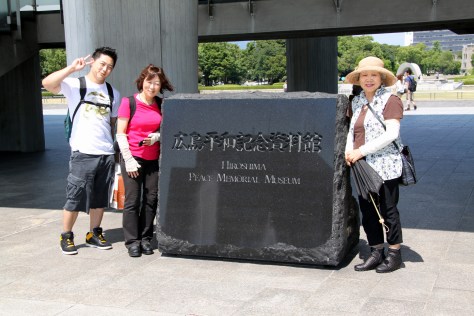
_______________________
It was an extreme emotional experience – not just for my oldest son Takeshi and I but for the kind souls who joyfully spent their afternoons with us on a hot September day in Hiroshima. I was able to finally meet – and thank – the people who were kind enough to seek out my father’s 1937 high school yearbook and thereby give my father a joyous remembrance of his most happiest days of youth in the sunset of his long life.
_______________________
Not being a writer, putting this experience into words is an endeavor. But on September 6, 2012, we were able to meet in person Mr. Tsukamoto, Ms. Kanetou, Ms. Tanaka and Mr. Aramaki.
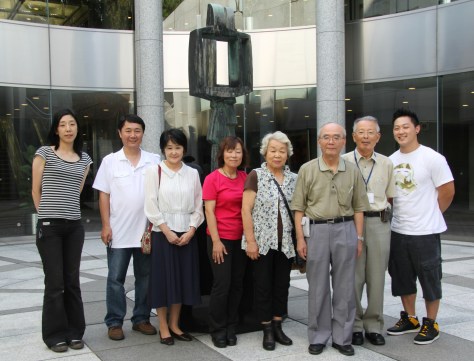
__________________________
Any guided tour is exceptional. A personally guided tour of a peace memorial and museum of a man-made event of unparalleled violence cannot be surpassed. Both gentlemen were severely burned as young children. With all doctors killed in the city, they had to resort to mashed yam salve to soothe their wounds. (To see a VERY well written piece on their atomic experiences translated into English, please feel free to read it here.) Imagine doing that yourself as a youngster.
They first pointed out where my father’s beloved high school, Nichuu, was situated in relation to the hypocenter. It is one thing to see it on your monitor. It is another thing to see it on a large wall map. Overwhelming. I knew it was close but it was not much further than one of my father’s triple jumps in Track and Field. It ceased to exist – as did over 320 of their young classmates.
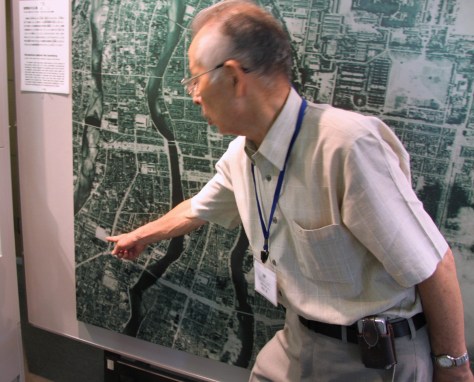
By destiny, both men – young children at that time being forced into laboring for Japan’s war effort – were saved by the decision of their instructor, Mr. Sekimoto. Mr. Sekimoto decided it would be best for small group of them (which included another one of my relatives) to clear a large parade ground to the southeast (東練兵場) for the next crop of sweet potatoes. The other classmates were sent to work on building a firebreak near Nichu – which sealed their fate. They were erased from the face of this earth in a second.

Due to time, we journeyed outside with these two 81 year old gentlemen for further education. However, without any inference of what was right or what was wrong 70 years ago, just a couple of images from within the Memorial Museum:

Messrs. Tsukamoto and Aratani guided us to the Nichuu High School Memorial, emblazoned with the 321 fellow students who perished. As did Mr. Tsukamoto on August 6th, 2012, I offered water; my son Takeshi also without any urging whatsoever left his precious water bottle on that hot and humid day which is a glorious gesture. There is a reason for the water as will be explained shortly.
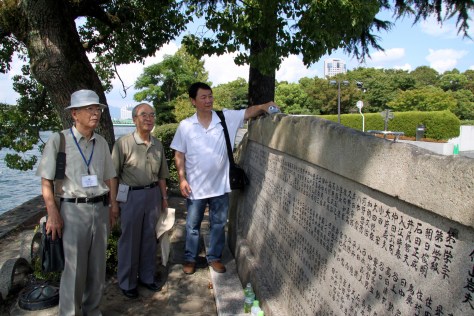

We journeyed towards the cenotaph. On the way through a park, Mr. Tsukamoto began to cry. I asked him what was wrong. He replied, “Your father is very fortunate to have family that think of his well-being. My soul is now filled with joy.” We hugged each other under the shade of a tree and cried together. As it turns out, his father died at a young age; he was never able to thank his father for raising him through a most horrible period.
We arrived at the cenotaph; the inscription was designed and written by Mr. Tsubokawa’s and Aratani’s good friend, Prof. Saika Tadayoshi. In English, it says, “For to repeat the fault we shall cease for we shall not repeat the evil.” It was purposely written with no subject. It is for the reader to decide. Mr. Tsukamoto subsequently sent this image of the actual manuscript of Prof. Tadayoshi written in calligraphy (brush and carbon ink).

The Atomic Dome can be seen perfectly centered through the arch. He explained the “eternal flame” is not truly meant to be eternal. It is to be extinguished when all nuclear weapons are abolished.
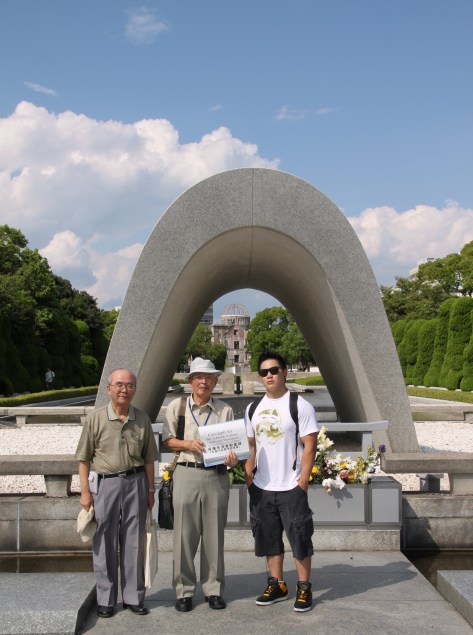
Just beyond the cenotaph can be seen a pool of refreshing water. The water symbolizes all the cries for water from the victims who survived the atomic blast. Nearly all would perish. Remember the water we poured on Nichu’s Memorial Stone?
We then walked to the actual hypocenter. The atomic bomb exploded about 1,900 feet directly above.
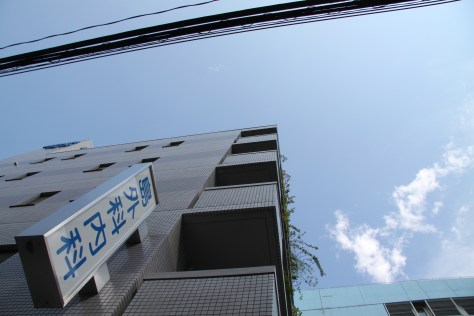
There are several rivers flowing through Hiroshima. We all know through books that the rivers were engorged with corpses and debris. However, there are no photos in existence as it was when the city was destroyed. There was no film let alone medical care. However, before the US scientists came to measure radiation levels about two months later, a huge typhoon hit the devastated city. While the rain tore through the rivers carrying the corpses out to sea, the rain also largely washed away radiation levels. Therefore, when the US scientists did measure the radiation levels, it was tremendously lower than what it truly was. You won’t find that written in any of our school history books.
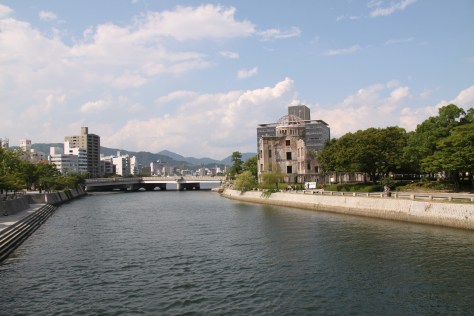
We returned from the very enlightening tour to join Masako, Izumi, Ms. Kanetou and Ms. Tanaka. My father was bestowed with many kind gifts one of which was a compilation of years past of Nichu – including images of when dad’s class was digging the pool at the school in the early 30’s. But lastly, as a small token of peace, fellow blogger Seapunk2 sent me some artistic pieces representing peace and serenity. One was presented Ms. Kanetou. I explained it to her that the artist said a sense of peace may be coming “…directly from her actions. You may feel the spirit contained within them. (I) sat so long and quietly, collecting those tiny pieces, sometimes with tweezers. It’s a beautiful experience, to listen to the shore birds, seals, waves and take in the Pacific while I gather the otherwise unnoticed gifts from the earth and sea. Then, once I got the idea for containing them, that, too, was peaceful and gave me a lovely sense of satisfaction…”
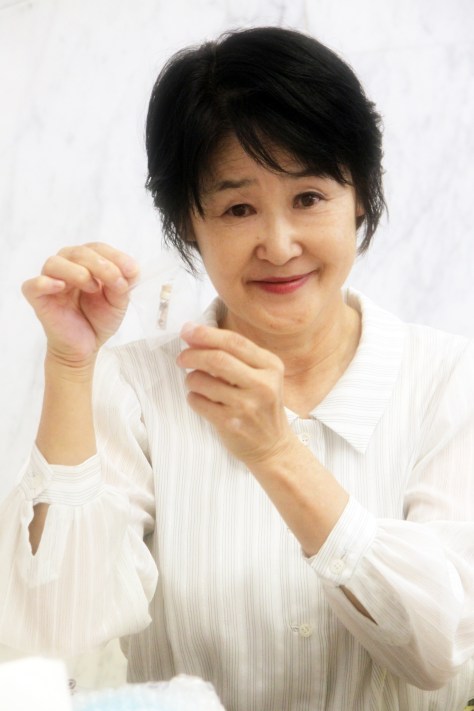
Lastly, in a photo discovery made just a few hours before meeting them, I came across a photo of dad taken in 1937 soon after he arrived back in Seattle after spending ten years in Hiroshima and graduating from Nichu. He’s sporting his Nichu varsity sweater. The attendees were overjoyed to see Dad’s pride in Nichu – even across the ocean.

__________________________________
The men were burned severely as children working in a field for their country’s victory. While their country lost, it was but a moment in their lifetime. They still attained victory for the world.
More to come on one family, two countries and World War II.


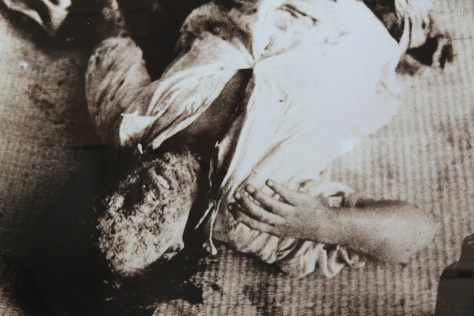
Mustang.Koji….I cannot imagine what these men and their friends and family lived through. We need to hear and read their stories. We need for this to never happen again. I hope the flame is extinguished in our life time, never needing lit again. Thank you for sharing this story, the pictures, and the emotions.
Thank you, Chatter Master, for your wishes for world peace. I only wish I could write like you!
What a wonderful compliment! But Koji, I enjoy your writing very much. I can write like me, but I cannot write like you. So if you wrote like me, who would write like you?
A bazillion other people! 😉
You need to listen to Jack NOW. 🙂
Okie-dokie, Mamo. 😉
LOL. Jack would be proud.
A beautiful post. Thank you. The memorial park was very moving for myself and my partner, two people with no background in Hiroshima, Japan nor Asia. I can only imagine what it was like to be in the place of your father’s youth. I hope you have memories to pass on to your grandchildren.
I am happy to read you enjoyed your visit there. As for memories to pass on, that is the primary reason for this blog. 🙂
The trip of a lifetime with your son. As always, you mix history with the present and allow us to learn while we share your experience. Very nice my friend!
You are always so very kind, Gar. Your family itself has a very colorful history – down to Omaha Beach, in fact. Thanks for stopping by.
Neat story. Wonderful family to travel to your father’s homeland. Thanks for sharing. Marilyn
Thanks, Marilyn. I hope the hurricanes down your way left you and your loved ones unharmed…
From start to finish, I could not keep my eyes dry.
…and I thank you for your artistic symbols of peace I took to Japan. My cousin’s granddaughter, Yuu-chan, has the all white charm… 🙂
It was and is my pleasure. I wonder how long it will take before Yuu-chan opens it… 😀
I don’t think you mean to open it like the glass tube? I gave it to her the second morning in Tokyo in a little box along with another gift. She opened them when she got home and thanked me on the third morning first thing! She’s a cutie pie, too.
I wish I could look into her eyes… 🙂
That must have been a difficult trip to make. So much devastation and death. Tragic. I pray for peace to all men, that this may never happen again.
Thank you. I think that’s their message!
Really good post, Pop.
Thanks, Punkie!
such a powerfully moving journey. thank you for sharing.
I’ve been away from the blog for a bit due to this and that…but I’ll be getting back to it quicker if time is good to me! 😉 Thanks for reading!
This is such a powerful and personal story I can barely contain myself. I am impressed by so many aspects of what you discovered. That the memorial is called a “Peace” memorial is indicative of the courage of the Japanese people. I already know that my mind cannot grasp the horror of what occurred, and to think that these dear men have survived to be emotionally stable, strong, kind men…I’m in awe. I don’t know why it never occurred to me that the doctors would all have been killed. I never thought of the injured taking responsibilities for their own wounds and recovery. Bottom line, you make me think long and hard with this post. I so badly want to believe that we will one day disarm all nuclear weaponry. I fear that is but a dream, but oh how I wish that were a reality! I will be thinking about this post for a long time to come. Debra
I cannot thank you enough for your stopping by and your feelings… That is exactly what their message is. Not of what was right or wrong 70 years ago but what is best for the future… 🙂 That is the message these two 81 year old survivors are seeking as well as my relatives.
I agree with Chatter Master – I also pray that we may see that flame extinguished in our life time…I don’t think I will ever forget the pictures you posted, nor should I – we should all remember and learn from the survivors. Blessings – Patty
Thank you so much for your heartfelt comments and feelings. They moved on with their lives – even salvaged them – and I will honor their message of a nuclear weapon-free world in the future.
It starts with one person…and reminds me of the song “Let There Be Peace On Earth” and I can’t think of a more honorable people to honor than the survivors and the ones that lost their lives in Hiroshima and Nagasaki.
“Let there be peace on earth
and let it begin with me
Let There Be Peace on Earth
The peace that was meant to be
With God as our Father
Brothers all are we
Let me walk with my brother
In perfect harmony……”
I am extremely touched by your thoughtfulness and heart, Patty. Thank you very much. I am sure they hear you.
Amazing story Koji, thanks for retelling it. I was about your sons age when I visited the Peace Memorial on the 45th anniversary of the bombing and I’ve always retold the story as it was one of those days that changed my life. I traveled there with my friend Mayumi’s Mom. I’ll never forget the museum then our walk to the dome. It was very emotional and I was in a zombie like state by the end overwhelmed by it all. It is a very powerful place. Whether you believe in the supernatural or not you can’t help but feel the emotion all around. It might be from every one there in the present or it could be from those who have passed, but it is real! I still need to get those photos scanned and posted.
It is quite the experience. What is unbelievable is that these two survivors (and three if you count my relative) were able to set their anger aside. They seek no pity. All they seek is a message of peace. Thanks for reading, Keith, and your sentiments/experiences.
You will be suprised what is being taught to Japanese children in their history books as it relates to WWII.
I”m sure very little if just a paragraph or two. When I went to public school in the 60’s here, three of my instructors were Marines who were in the Pacific. They showed no hatred nor discrimination towards me. In ’64, I remember my teacher cried in front of class when she announced MacArthur passed away.
Our history textbook back then had many pages (if not a chapter or two) on WWII – even describing how Japanese soldiers were rarely captured (which wasn’t true towards the end of the war).
On the other hand, I looked at my 6th grader’s textbook. The number of pages on WWII has diminished considerably. Of course, it mentions Pearl Harbor, the bombing of London, the atomic bombing only (omits Dresden and Tokyo) and the surrender. Unbelievably, there was a brief mention of the Japanese-American imprisonment.
I don’t know how I missed this Koji. It has been up for months, but I only just saw it. Forgive me. It is a facinating and moving post, thank you or sharing this history. Also you modestly say you are not a writer… and then you write these words which are delivered seemingly without effort yet convey so much;
“Mr. Sekimoto decided it would be best for small group of them (which included another one of my relatives) to clear a large parade ground to the southeast (東練兵場) for the next crop of sweet potatoes. The other classmates were sent to work on building a firebreak near Nichu – which sealed their fate. They were erased from the face of this earth in a second.”
Those few sentences sum up much of the horror – that civilians were going about their routine daily business when in an instant everything changed forever. We all know that during WWII civilians in many parts of the world were in the frontline but at Hiroshima that was taken to a new and horrific level, and one without warning or without comparison until Nagasaki. And so it remains.
Excellent write up Koji, and apologies again for having missed it.
Ian
Reblogged this on Masako and Spam Musubi and commented:
While it is August 6th here in the States, it it the 7th already in Hiroshima. I offer this story in hopes of peace.
Reblogged this on THE RED KIMONO and commented:
If you want to know what it was like that day, 70 years ago, when the bomb was dropped, read this.
Koji says he’s not a writer, but in stories like this one about his family’s history in Hiroshima, I beg to disagree.
Seventy years and 5,000 miles can provide enough distance that we may not always look at the personal impact of such a horrific event. Thank you for writing this story and posting pictures, Koji.
I’ll admit, before I visited the memorial, I thought of that day as a day in our history books, as a day that had to happen to end the war. But after my visit, it became more real and I thought to myself that we should never, ever use such a weapon again.
Your stories of your family make the event even more real. And Koji, I beg to differ…you ARE a writer.
You are a very kind person, Jan. Thanks for the reblog, first of all and second, for your feelings about the bomb. I still cannot get over how these survivors can have but forgiveness in the hearts.
I read this before, so I knew it deserved another visit. How noble of Takeshi to follow the traditions and leave his water bottle – you have a great son there, Koji.
Thanks, gpcox, for stopping by again and for your kind thoughts.
So many people need to be reading this Koji!
I also hope one or two read the English version of the survivors’ experiences…
改めて色々考えさせられました。本当にありがとうございました。
広島にご親戚住んでいますか?
地元は四国(愛媛県)ですので、広島も「近く」感じます・・・
A very moving blog post. Thank you for sharing it with us.
Thank you for always stopping by, sir. May your weekend be enjoyable!
This was difficult to read – I clicked on the link and read the stories of the children who were there. This was so moving and courageous.
Thank you for taking a look at their story, Hilary. It was a very good translation… And can you please insert a link to your blog? I’m sure it’s just me but I just can’t get to your blog… 😦
My thoughs and prayers were with you, your family and all of those who lost their lives and those that suffered.
The whole world suffered, yes? And the sad thing is people are now unaware of the magnitude of the unknown courage shown by folks of that period… from the parents giving the small amount of food they could find to their children to the young sailor taking a dozen Marines to the invasion beach to enslaved prisoners…
It is a terrifying thought to think that once people forget or don’t care that they will repeat history.